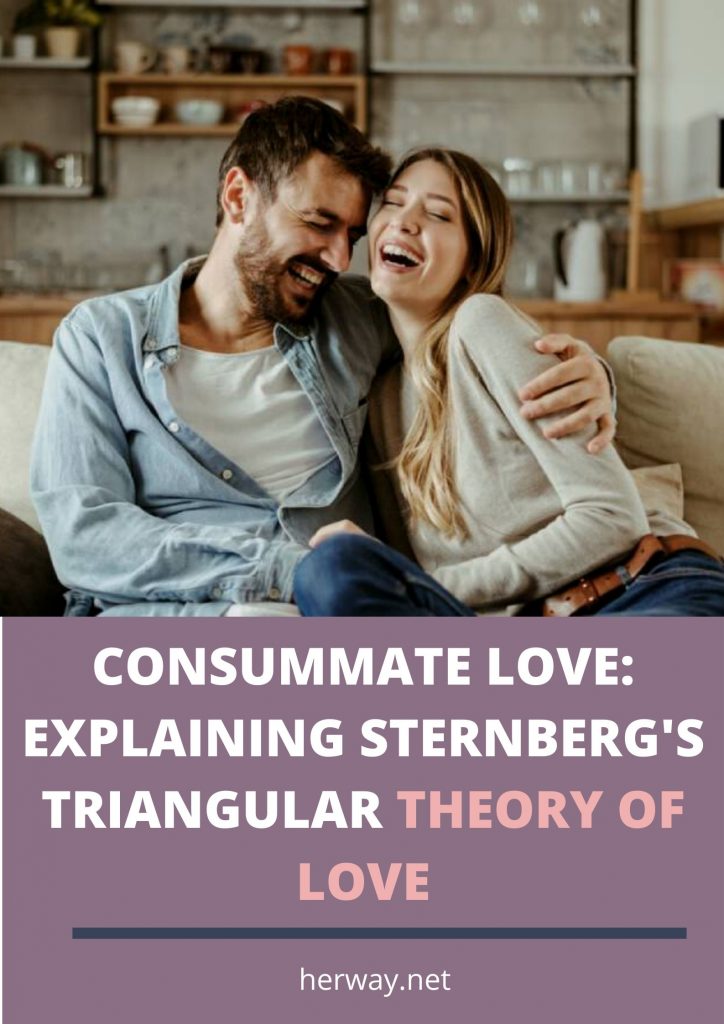Consummate Love: Explaining Sternberg’s Triangular Theory Of Love
We are all put on this earth on a quest in search of that perfect, never-ending romantic love.
But what most people don’t have a full grasp of is the fact that there are many types of love out there and if you and your true love share physical attraction but aren’t compatible in all the components of love, trouble may ensue.
The triangular theory of love is a framework developed by psychologist Robert Sternberg to help shed some light on this intricate matter of the different forms of love and help differentiate non-love and mere sexual attraction from the type of love that entails deeper characteristics.

Sternberg’s theory aims to pin down the basic elements of romantic love and bring us closer to understanding the type of relationship we’ve created with our best friend/true love and lead us to a healthier loving relationship.
Consummate love is at the very core of this significant research by Sternberg and along with companionate love, fatuous love, empty love, infatuation and a few other kinds of love, it is a crucial part of a triangular theory of love, which you can find detailed in his Psychological Review article.
Robert Sternberg’s research at Yale University aims to break the mold about the major differences between passionate love, which consists of a lack of commitment but thrives in sexual attraction, and other forms of love that lead to a long-term relationship.
While consummate love is the core of all healthy romantic relationships, Robert J.

Sternberg brings us closer to the kind of love which consists of commitment components that don’t necessarily scream passion+intimacy and the types of relationships which can be described as love at first sight.
There are so many different combinations of true love and each one has the potential to lead to a long-term commitment, provided that both partners are on the same wavelength in their love relationship.
See also: How To Be A Good Girlfriend: Raise The Bar With These 20 Simple Tricks!
The Essence Of The Triangular Theory Of Love

In order to have a firm grasp of the essential elements of love relationships, Sternberg has developed a deeply insightful framework in which he explains in great detail the basis of his discoveries regarding consummate love, along with all other forms of love.
Sternberg goes on to explain that there are, in fact, eight different kinds of love in his triangle of love theory, which all stem from three key components: passion, intimacy and decision (also mentioned as commitment).
If your romantic love relationship consists of only one of the aforementioned components (let’s assume that there’s intimacy but you’re lacking in the passion and commitment departments), according to Sternberg, your love falls under the category of a more simple, basic form of love.
On the other hand, if your relationship has two of these components (for example, passion + intimacy but a lack of commitment), you’re on the right track but it’s still far from consummate love.

And if your relationship contains all three of these components of love, then congrats!
That means that your form of relationship is known as consummate love.
Sternberg’s triangular theory of love aims to open people’s eyes to the real nature of their romantic love and guide them toward the kind of love where they’ll exchange infatuation for true, meaningful romantic love and get to the same level of commitment.
See also: The Ultimate List Of Couple Goals For The Happiest Relationships
The Three Components Of Love

In order to help you better understand the triangular theory of love and explain all types of love, including consummate love, let’s delve deeper into the three key components of love and understand their roles in Sternberg’s triangular theory.
Without them, there is no ultimate form of love, which is why you need to pay close attention and learn from Sternberg’s dedicated research into what makes love grow and evolve.
• Intimacy is the component of a relationship that lets you feel warmth and closeness with your true love.It’s the feeling that once felt can never go to oblivion. It’s difficult to describe it with words as it’s something that needs to be felt in order to be fully understood.
• Passion is the essence of sexual attraction between two people. Passion is the driving force that creates sexual tension and deep physical attraction in a love relationship.

• Commitment is the core of a long-term relationship. It’s a constant decision to put your best friend first and remain loyal to them no matter the obstacles. Consummate love doesn’t exist without this key component of love. Along with the other two, it creates what Sternberg would call jackpot love (consummate love).
All of these components of love are vital in keeping a romantic love afloat and give it a chance of becoming the ultimate form of love—consummate love.
But in some cases, not all are present, although this doesn’t mean that there’s anything wrong with those relationships.
Every long-term relationship has the potential to achieve the highest goal.
According to Sternberg, these components may vary, depending on the type of love.

For example, a married couple may lack in the passion department when they bring a child into their world but their levels of intimacy and commitment will increase significantly.
It all greatly depends on the stage of the relationship and their ultimate goal of where they want it to go.
Consummate love is what many aspire to but until you get there, you’ll first need to understand (and likely go through) the eight other types of love to be able to fully understand, appreciate and cherish consummate love.
See also: Feeling Defeated And Lost? These 10 Things Will Help You Cope
The 8 Main Types Of Love

The triangular theory of love offers incredible insight into what these eight kinds of love consist of and how they are all interconnected through the three key components of love.
Keep in mind that your relationship may not fall straight into one of these categories but Sternberg’s framework will hopefully help you understand your current relationship (along with your past relationships) and see it in a whole new light.
1. Non-love

As the name itself suggests, when all three components of love are evidently missing from your romantic relationship, you’re dealing with a non-love type of relationship.
These kinds of relationships are usually among two casual friends who haven’t gotten to know each other well yet.
It can be characterized by a lack of passion, intimacy and commitment.
There is no fire, no closeness and no plans to take the relationship to the next level.
The person you’re having this type of relationship with does not hold much merit in your life and you could easily live without them by your side.
2. Liking

When you’re dealing with liking, you’re probably close to someone to an extent (which can be described as intimacy) but there’s a palpable lack of commitment and passion.
This stage is what most couples start with, with a very high chance of their relationship transforming toward consummate love at some point.
As long as there’s will on both sides to move forward, there’s a chance of it becoming healthy romantic love.
3. Infatuation

An infatuation is a form of love characterized by a fiery sexual attraction that according to a triangular theory of love doesn’t amount to a complete type of love.
While this relationship is passionate and physical, it’s lack of intimacy and commitment makes it far from consummate love.
People who are in this type of relationship often cannot keep their hands off each other which often results in PDAs.
While infatuation is a vital aspect of a relationship, it’s necessary for it to evolve into a deeper connection in order to sustain itself on a long-term basis.
See also: What I Love About You: A List Of 100 Reasons Why I Love You
4. Empty love

During the course of this type of relationship, the couple struggles to keep the relationship alive due to a severe lack of passion + intimacy.
Empty love has commitment but the lack of the other two components makes it hard to keep it afloat.
This usually occurs with an older couple whose relationship has sadly become stagnant.
5. Romantic love

According to Sternberg, when you combine passion + intimacy, you get romantic love.
Now this may seem like the type of love one should aspire to but there’s something missing: commitment.
This often occurs in romantic relationships where one partner wants to commit but the other one isn’t ready.
There’s attraction and there’s a connection but it’s incomplete due to its one-sided nature.
A love relationship of this kind can sustain itself for a little while but it’s more likely to fizzle out due to a severe lack of commitment.
6. Companionate love

Companionate love is the type of love where commitment and intimacy are very present but passion is absent from this equation.
For long-term commitment, a romantic couple needs to evolve from this kind of love and find that fire that’s missing.
This is usually between two close friends who have forged a strong bond which became a relationship but unfortunately, it’s one that lacks sexual attraction.
It is up to them to decide whether their love will move forward and find that missing component or let it run its course, accepting the reality as is.
See also: A Kiss On The Cheek: Meanings And 12 Different Types Of Kisses
7. Fatuous love

In this type of love, there is passion and there is commitment but intimacy is visibly absent.
While any type of relationship has a certain amount of potential to amount to something deeper, according to Sternberg’s triangular theory of love, this one is unlikely to last.
In order to forge a bond strong enough to stand the test of time, one needs intimacy.
Without it, there’s no trust and without trust, there’s no basis for a long-term relationship.
Therefore, fatuous love is not one to aspire to as it won’t last very long.
8. Consummate love

And finally, we’ve come to the ultimate type of love that is the core of Robert Sternberg’s triangular theory.
Consummate love. The name itself gives you an indication of complete love.
Why? Because it contains all three components of love.
According to the triangular theory of love, everyone should aspire to have this type of love.
But once you attain it, don’t think that your work is done.
Even in this relationship, one always needs to make sure to work on it, nurture it and put serious effort into it.

In order for a relationship to flourish, it needs to be constantly watered.
Wherever you find yourself on the journey of love right now, don’t try to rush into something you’re not ready for.
Sternberg’s framework serves a unique purpose of helping you understand where you are so that you can see where you want to go.
Conclusion
Whether you’re in a consummate relationship or still on your journey toward it, one thing needs to remain crystal clear; a relationship won’t grow unless you make it so.
Make sure to allow all three components of love in your romantic relationship and never ignore one of them.

Without passion, intimacy and commitment, you cannot expect to achieve what Sternberg’s research has explained as the complete type of love.
Take this as a guide toward attaining what you’ve been yearning for, without skipping any steps in the process.
The triangular theory of love is a deep insight into the ins and outs of all types of romantic relationships and how important it is to always keep striving for more.
Consummate love is not unattainable; it’s simply a deeply progressed form of love that only the most loyal and dedicated can hope to achieve.
See also: Top 10 Signs You’re Not Ready For A Relationship Right Now







